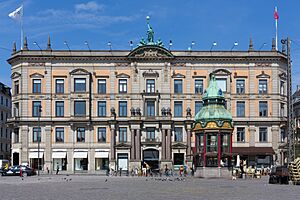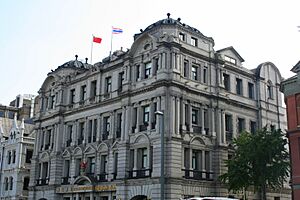GN Store Nord facts for kids
 |
|
| Public | |
| Traded as | OMX: GN |
| Industry | Electronics |
| Founded | 1869 |
| Founder | Carl Frederik Tietgen |
| Headquarters | Ballerup, Denmark |
|
Key people
|
|
| Products |
|
| Revenue |
|
|
Operating income
|
|
|
|
| Total assets | DKK 23,552 million (2021) |
| Total equity |
|
|
Number of employees
|
7,228 (2021) |
| Subsidiaries |
|
GN Store Nord A/S is a company from Denmark. They make cool stuff like hearing aids, headphones, and equipment for video calls. They also make gaming gear.
You might know their brands like Jabra, ReSound, and SteelSeries. GN Store Nord is listed on the stock exchange in Copenhagen, Denmark.
Contents
History of GN Store Nord
The Great Northern Telegraph Company: Early Days
The company started in Denmark in June 1869. It was first called The Great Northern Telegraph Company. A Danish business leader named Carl Frederik Tietgen brought three smaller telegraph companies together. Their big goal was to create a telegraph network all over the world.
The company's journey began with an agreement with the Russian Tzar in 1869. This deal gave The Great Northern Telegraph Company special rights to build and run a telegraph line in Russia. This was a huge and important job to connect Europe to the Far East.
The company also helped the Russians with their telegraph lines. They offered help with operations, maintenance, and training. A naval officer named Edouard Suenson led the company's work in Asia. He later became the CEO in Copenhagen in 1877.
Expanding Telegraph Lines Around the World
In the years that followed, the telegraph lines grew a lot. They spread across Europe and Asia. First, cities like Oslo, London, and Paris were connected. Later, the lines reached along the coast of China, from Hong Kong to Shanghai. They also went into Japan, with the first station opening in Nagasaki in 1897. Many telegraph stations and offices opened in different places.
In 1897, there were talks about connecting Scotland to the United States. This would happen through the Faroe Islands, Iceland, and Greenland. The cable was finally set up in 1906. But the connection to the United States took almost 60 more years. When it was finally made, it was a big step. It made communication around the world much easier.
The early 1900s had many wars and disagreements. These events affected the company's work. World War I and the Russian Revolution changed Europe. But this only made people want telegraph services even more. The company even got its agreement extended by Lenin in 1921.
Challenges and New Directions
The 1920s and early 1930s were great years for The Great Northern Telegraph Company. It was known as one of the top communication companies globally. However, the late 1930s brought big problems. New wireless telegraphy was becoming very popular. Also, World War II badly damaged telegraph lines worldwide. By 1945, the company only had two lines left.
Even though broken lines were fixed after the war, the company knew things had changed. So, they decided to try a new plan. They started investing in different types of companies. This began in 1939 with an investment in a battery factory called Hellesens.
Over the next few decades, The Great Northern Telegraph Company invested in both communication and other industries. They invested in companies like Lauritz Knudsen, which made electrical goods. In 1947, they started Storno, a company that made radio telephones. Other companies they bought included Telematic (telephones), Elmi (measuring equipment), and Danavox (hearing aids).
GN Store Nord: A Modern Company
In 1985, The Great Northern Telegraph Company changed its name to GN Store Nord. GN stands for Great Nordic. This was to create a new group identity. All their smaller companies were renamed to include "GN," like GN Danavox.
A big change happened in 1991. GN got a special license for a mobile phone network in Denmark. In March 1992, GN's new company, Sonofon, launched Denmark's first private mobile network. GN owned most of Sonofon's shares.
With the growth of data communication and phones, GN became very successful in the late 1990s. In 2000, they sold Sonofon to a Norwegian company for a lot of money.
GN then invested a large amount in its company NetTest. NetTest had grown from the old Elmi company. GN thought NetTest would be their main business. They decided to buy a French company called Photonetics for a huge sum. The company's stock price went up five times in just one year. In the same year, they also bought the American company Jabra.
However, the focus on NetTest led to big problems. GN had misjudged how the market for NetTest's products would grow. In 2001, the company lost a lot of money. The stock price dropped, losing all the gains from previous years. Many shareholders were very upset.
The next few years were difficult. The company sold most of its smaller businesses. They also moved from their old headquarters in Copenhagen. GN Store Nord's main office is now in Ballerup, Denmark. GN decided to focus on two main areas: hearing aids and headsets. These are made by GN Hearing and GN Audio.
In 2006, GN planned to sell its hearing aid business (GN Hearing) to a Swiss company. But the deal was stopped by German authorities. After this, GN decided to keep the companies.
Even though the deal was blocked, GN faced big challenges. They had two businesses that were not doing well. They also had a lot of debt. But with hard work and changes, the company managed to survive. Since then, GN has slowly gotten back on track.
In 2009, GN Audio decided to sell all its products under one brand: Jabra. GN had bought Jabra in 2000. The goal was to become the world's top supplier of headsets.
Today, GN Audio is a world leader in headsets for Unified Communications. In recent years, they have launched many new products. In 2014, they released the first sports headset with a heart rate monitor. They also launched noise-canceling headsets. These are designed to help people focus in noisy offices.
GN Hearing also improved. In 2010, they launched the first hearing aid with 2.4 GHz wireless technology. This was a big improvement. In 2014, GN Hearing changed the industry again. They introduced the first Made for iPhone hearing aid. This allowed sound to stream directly from an iPhone without extra devices.
In October 2016, GN Audio bought VXi Corporation. This company made the VXi and BlueParrott headset brands.
What GN Store Nord Does Today
Today, the GN Group includes GN Store Nord A/S, GN Hearing A/S, and GN Audio A/S. GN creates and makes smart hearing, audio, video, and gaming products. GN's products are sold under brands like ReSound, Jabra, SteelSeries, Beltone, Interton, Danavox, and FalCom. They sell their products in over 100 countries around the world.
55°44′19″N 12°23′12″E / 55.73861°N 12.38667°E
Leaders of GN Store Nord
Here are some of the people who have led the company:
- (1873–1908) Edouard Suenson
- (1995–2001) Jørgen Lindegaard
- (2023–present) Peter Karlstromer (Group CEO GN Audio / GN Hearing)



